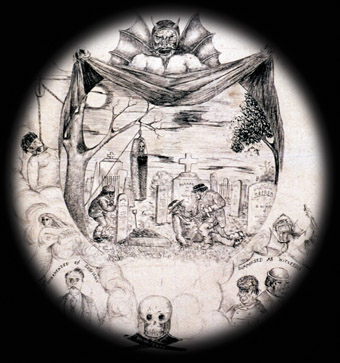tasmanian horrors real & mythic
andrew harper sees new filmmakers go gothic

Bernard Lloyd, Homo Tasmanicus, image courtesy of WL Crowther Library, State Library of Tasmania
THAT THERE IS A NOTION OF TASMANIAN GOTHIC IS A LONG ACCEPTED ONE; A DEFINITION OF WHAT IT MIGHT CONSIST OF IS QUITE ANOTHER MATTER. I HAVE MY OWN VERSION, OF COURSE, AND IT MAY WELL BE QUITE DIFFERENT FROM THE INTERPRETATIONS PRESENTED TO AN ENTHUSIASTIC GROUP OF LOCAL FILM WATCHERS IN THE PEACOCK THEATRE, ITSELF A ROOM THAT ECHOES WITH AN OLD UGLINESS. THIS COMFORTABLE VENUE IS LOCATED ALMOST PRECISELY IN THE AREA WHERE WHALES WERE CARVED INTO MORE MANAGEABLE CHUNKS WHEN THE TOURIST PRECINCT OF SALAMANCA WAS ONCE A THRIVING DOCKLANDS. TYPICAL TASMANIA REALLY: AWFUL YARNS AND FACTS ABOUND ALL THROUGH THE PLACE, FROM MINOR DETAILS TO DEEPER HORRORS OF GENOCIDE AND EXTINCTION. THERE ARE A LOT OF WAYS TO GET THE CREEPS ON THIS COLD ISLAND.
The event I was attending was the screening of the results of a pilot guerilla filmmaking program run by the energetic Rachel Lucas and facilitated by Wide Angle Tasmania, an organisation that lives up to its name, presenting programs like this one, teaching more advanced, focused technical skills and screening local filmic endeavour.
Guerilla filmmaking is, like Tasmanian Gothic, another term open to varying interpretation, but it was easy to see what it meant here—get a camera and get going. The films were shoestring budget efforts, made to a tight schedule that left little time for contemplation or frippery. The emphasis on demystifying process and empowering these newer filmmakers to tell their stories and make screen-ready narratives yielded varying results, but one has to start somewhere, and this program was about getting people out of the blocks. I must admit to liking this kind of approach a lot and it echoes the old punk adage: this is a guitar, these are three chords, now form a band.
Rachael Lewis’ awfully tense footage of a chicken attempting to cross a road seemed to be a gag but then got quite dreadful as the possibility of seeing something die on screen was dangled. The film was called Les Roadkill and we’d already been treated to loving close-ups of car-damaged native animals by the time the chook appeared.
Watching Vivien Mason’s Two Heads Are Better Than One I was prepared to dismiss a discussion of the old two-headed Tasmanian myth as just too daft, but this documentary style film did its research well, finding an explanation for the myth—a lack of iodine in local soils had resulted in a plague of goitre and consequent neck scars—before presenting a chap who had made a decent living out of selling two-headed images on postcards. Another documentary, Tracie Walsh’s Slaughter at Pittwater, led us into the uglier aspects of Tasmania’s history, discussing an Indigenous massacre, Aboriginal resistance and a subsequent legal cover up.
The jewel in the crown of this screening was Homo Tasmanicus by Bernard Lloyd, a terrific research effort into the true tale of a gruesome tussle by factions of doctors for the possession of the body of one the last of the Tasmanian Aboriginal people, William Lanny. The narrative is constructed from extensive quotations from letters of one Doctor Crowther, who so coveted the scientific prize that he was oblivious to human dignity. This ugly tale, filled with midnight digging, body snatching and dissection yielded a feeling of hideous, immoral murk. The awful narrative was well supported by a smart decision to use extant historical imagery, all made to resemble the projections of a magic lantern, that ancient flame powered device that predated film itself. This was the Gothic moment of the evening, the screen mostly black, allowing us to peer voyeur like into our hideous past. Satisfyingly nasty.
Wide Angle Tasmania, Summer Screen Safari: Tasmanian Gothic, Screening and Discussion; Peacock Theatre, Salamanca Arts Centre, March 12; www.wideangle.org.au
RealTime issue #85 June-July 2008 pg. 18






